
Tell us what you need to find a matching loft conversion specialist

Get free quotes from professionals near you

Compare offers and choose the one that best matches your need
- Householdquotes.co.uk
- Home Insulation
- Insulation Costs
House Insulation Costs in the UK 2025
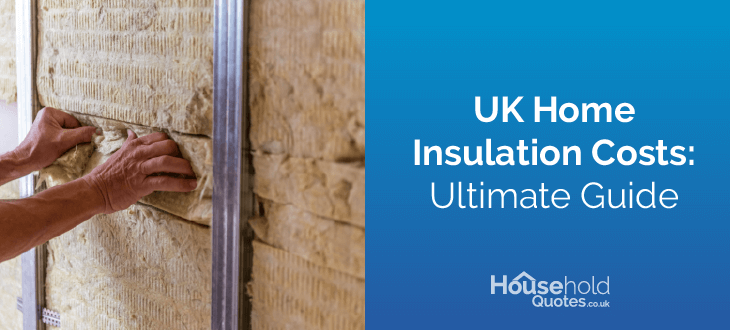
- Insulating a 3-bedroom semi-detached house in the UK can cost around £12,930 for wall, floor and loft insulation.
- Complete home insulation can bring savings up to £630 - £730 year on year.
- VAT charges on housing insulation projects have been removed by the UK government as far as March 2027.
Households across the UK are feeling the pressure of rising energy bills as living costs keep on climbing. The core of this issue lies in energy-inefficient properties, a problem that grips 4 in 10 households in the UK with poor wall insulation alone.
A great solution to slashing your energy bills is by getting effective home insulation. Proper wall, floor, and loft insulation can generate energy bill savings of up to £730 every year, as well as reduce your annual household CO2 emissions by up to 1.7 tonnes.
In a bid to support the UK’s transition to net zero by 2050, the government also rolled out two key schemes - the ECO4 and The Great British Insulation Scheme - to assist low-income and fuel-poor households with energy efficiency upgrades.
If you’ve been wondering; how much does it cost to insulate a house? Then you’ve come to the right place. In this complete guide, you’ll get insights into expected house insulation costs, savings, as well as existing government schemes that you might potentially benefit from.
Ready to insulate your home? Here at Household Quotes UK, we can free you from the burden of countless hours in research and vetting by taking care of the hard work for you. To gain access to our wide-spanning network of trusted local installers, simply fill out our 30-second form and receive up to 3 free home insulation quotes tailored to your needs. No extra fees or obligations are attached. Click below to begin!
- Describe your needs
- Get free quotes
- Choose the best offer
It only takes 30 seconds



How much does insulation cost?
Insulation costs for a 3-bedroom semi-detached home in the UK can sit around £12,930 for combined wall, floor, and roof or loft insulation. However, the cost of insulation can vary based on the specific conditions of your home, budget, difficulty of installation, and other factors.
To give you a thorough understanding of the average costs and savings you can expect per home insulation type in 2025, check out our table below:
| Insulation type | Installation costs | Energy bill savings (£/year) | CO2 savings (kgCO2/year) |
|---|---|---|---|
| Cavity wall (270mm) | £2,700 | £280 | 650 |
| Solid wall (internal) | £7,500 | £380 | 880 |
| Solid wall (external) | £12,000 | £380 | 880 |
| Floor (suspended timber) | £4,700 | £80 | 185 |
| Loft | £930 | £270 | 620 |
| Windows | < £15,000 | £165 | 375 |
| Doors | £840 – £4,325 | £45 | - |
| Pipes and Water Tank | £38 | £226 | 715 |
Roof & loft insulation costs
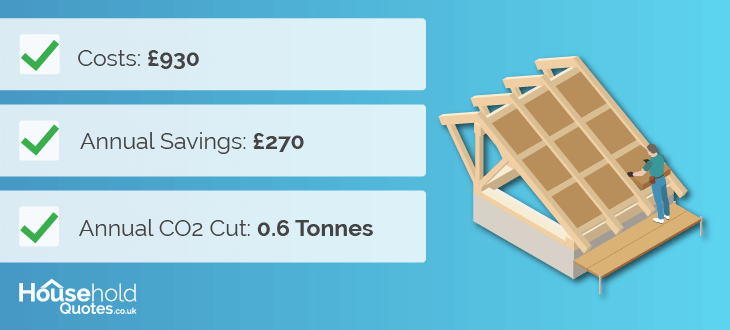
Roof and loft insulation can generate up to £270 in annual energy bill savings despite only costing around £930 for a 3-bedroom semi-detached home in the UK. This means roof or loft insulation boasts an impressive 3-year payback period in comparison to some other insulation upgrades.
A study by the Resolution Foundation (RF) concluded that up to 20% of UK homes have no roof or loft insulation at all. Considering that uninsulated roofs are responsible for over 25% of heat loss in a home, it’s no surprise that so many homes suffer from high energy bills.
Roof and loft insulation provides some of the most versatile options for insulation, even including some DIY options. There are generally four main approaches to roof and loft insulation you can make use of:
- Blanket insulation
- Most popular for loft insulation.
- Available in rolls or batts.
- Made of mineral wool (glass or rock), fibreglass, or sheep wool.
- Loose-fill insulation
- Made of shredded fibres that can be spread evenly, or blown into crevices.
- Useful when insulating awkward shapes and uneven joists.
- The most popular material is cellulose (recycled paper products), but other forms include fibreglass and mineral wool variants.
- Sheet insulation
- Available as rigid boards and used for insulating roof undersides.
- The most common type is expanded (EPS) or extruded (XEPS) Polystyrene, but can also be made from Polyisocyanurate and Polyurethane.
- Blown fibre insulation
- Very useful when insulating difficult-to-access loft areas.
- Blown into crevices or cavities using a special applicator gun.
- Most commonly found as Polyurethane (PUR) foam, but some loose-fill insulation can also be applied the same way.
Floor insulation costs
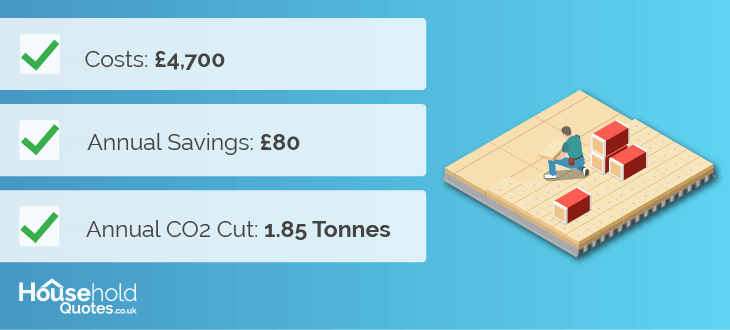
Floor insulation for an average UK home can cost up to £4,700, depending on various factors. However, the good news is that you can recoup this cost through annual energy bill savings of around £80. In most cases, insulating just your ground floor will provide sufficient warmth throughout your house.
Since 1990 in the UK, building regulations require the ground floors of properties to be insulated to conserve energy. In England or Wales, your floor insulation should achieve a U-value of around 0.25 W/m2K. U-value measures how quickly heat can travel through the floor.
Your exact costs will depend on several factors:
- Floor space: Naturally, larger spaces will require more insulation and thus you’ll have higher material and installation costs.
- Existing insulation: If you already have some insulation in place, then the additional cost to top up will likely be lower than starting from scratch.
- Floor-type: Concrete floors tend to be more expensive to insulate than suspended timber floors.
Concrete floors are common in newer UK homes and require rigid insulation boards (such as PIR) to be added underneath or on top of the concrete. These tend to cost around £10 to £17.5 per m2 based on the material's effectiveness. Given the nature of the job, it’s advised to insulate with a professional installer, ideally when your floor needs repairing or replacing.
Suspended timber floors are found in most older UK homes and are easier to insulate. They have floorboards laid on joists that sit above the foundation of your property. The gap between the floorboards and foundation serves as ventilation to ensure the floorboards don't rot. Insulation is normally placed in between the joists, with the floorboards laid on top.
Wall insulation costs
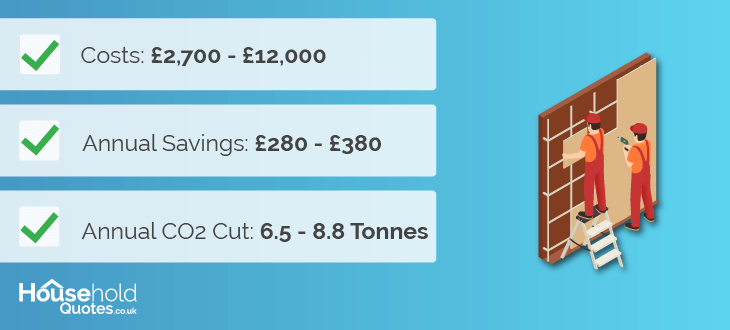
The cost of wall insulation can vary widely, ranging from £2,700 to £12,000. This depends on:
- Your wall type: Insulating solid walls is a more complex and labour-intensive job than cavity walls, typically costing more.
- Existing insulation: If you already have some functional and properly installed insulation in place, the cost of topping up will be lower.
- Length of external walls: Bigger houses naturally cost more to insulate due to the need for more material and labour.
While these upfront costs may seem daunting, you’re rewarded with impressive energy bill savings of £280 to £380 yearly. Not to mention, uninsulated walls contribute to around one-third of your home's heat loss, making it one of the most worthy energy efficiency investments you could make.
Here's a breakdown of typical UK wall types and what they entail:
- Solid walls: Built pre-1920s, these single brick walls typically lack insulation and require a mix of internal or external wall insulating. Almost 97% of these homes lack proper insulation. Generally, solid wall insulation is far costlier than cavity walls.
- Cavity walls: Common in post-1920s properties, these have a gap or ‘cavity’ between the inner and outer walls of a property that can be easily filled with insulation such as polyurethane foam. Still, over 25% of cavity wall homes lack proper insulation in the UK.
Price of insulation materials
Looking for the perfect insulation for your budget? We’ve got you covered. While insulation prices vary depending on the supplier and insulation type, plenty of options exist for every wallet.
Generally speaking, the price of insulation tends to reflect the material's effectiveness in insulating, the ease of production, as well as market availability.
Let’s explore some popular choices on the market and the corresponding insulation prices:
| Material | Uses | Average cost (per m2) |
|---|---|---|
| Fiberglass | Floors, roofs, lofts, and walls. | £10 |
| Polystyrene (EPS) | (External) walls, floors, roofs, and lofts. | £10 |
| Cellulose | (Cavity) walls, lofts, open attic, and roof cavities. | £10 - £12 |
| PIR Board | (Solid and cavity) walls, roofs, and floors. | £5 – £15 |
| Mineral Wool (Glass) | (All) walls, floors, roofs, lofts, and piping. | £13 - £17.5 |
| Sheep's wool | (All) walls, floors, roofs, lofts, and piping. | £17.5 - £22 |
| Polyurethane (Foam) | (Cavity) walls, floors, roofs, and door/window. | £21.5 |
Is it worth insulating my house?
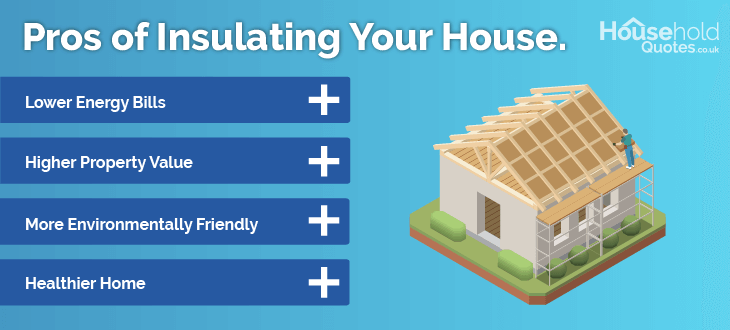
While the cost of insulating a house might seem steep, the benefits proper insulation brings certainly make it worthwhile. Let’s take a look at some:
- Slash your bills: You can save up to £650 on your annual energy bills with insulated walls and loft. Proper home insulation brings unmatched savings by cutting over 60% of your home's heat loss. This means your heating system doesn't have to work as hard to keep topping up lost heat.
- Boost your investment: Insulating your home will raise its Energy Performance Certificate (EPC) rating, making your home far more valuable and attractive on the housing market if you ever plan to sell it.
- Help the planet: The UK housing market is a notorious polluter, even surpassing all of the cars in the country combined. Making sure your house is properly insulated can help you reduce your domestic carbon footprint by up to 1.7 tonnes every year.
- Healthier home: Drafty and damp homes are often ridden with mould and rot. Not only does this damage your home's structural integrity, but can also increase the risk of dangerous respiratory illnesses and prolonged flu.
Are there grants to reduce the cost of insulation?
If you qualify as a low-income household or lack proper home energy efficiency, you may be in luck. The UK government rolled out several grants and schemes designed to help such households cover the cost of energy efficiency upgrades, thus making your home warmer, cheaper to heat, and more eco-friendly.
There are two major nationwide schemes currently active until March 2026:
The Great British Insulation Scheme: Designed to deliver insulation solutions for low-income homes to reduce fuel poverty and cost of living. The scheme compliments ECO4 by delivering ‘one-off’ insulation measures per household in a bid to maximise reach across the UK.
The ECO4 Scheme: Not a grant scheme, but an obligation set on energy companies to deliver energy efficiency measures to the least efficient UK homes suffering from fuel poverty. ECO4 mainly applies to homes with an EPC rating of D to G and offers wide-spanning upgrades including insulation, boiler repairs, and central heating.
Can I save money by insulating my house myself?
Considering taking on some DIY insulation projects in your home? The savings are indeed tempting, potentially reducing your costs by up to 70% compared to professional installation, but there are certainly some risks to consider.
Here are just a few to keep in mind:
- Safety risks: Insulation materials can be hazardous to work with. Fiberglass and mineral wool are highly irritable to the skin and respiratory tract, while foam-based insulators use highly harmful chemicals that can cause long-term damage if ingested. Professional installers are trained and equipped to handle these materials safely.
- Quality assurance: A professional accredited installer can ensure the job meets regulations and addresses any underlying structural issues with your home, preventing future problems. DIY mistakes can be far more costly to fix later.
- Time vs. expertise: Professional installers can finish jobs quickly and efficiently, and their work tends to last longer. DIY installations can take time and might not be as durable in the long term.
Compare quotes from several companies for the best price
Finding the right accredited installer is almost as important as getting your home insulated in the first place. A professional installer can be the difference between a long-lasting efficient home solution, and a shabby nightmare that keeps on racking repair bills.
It's important to compare insulation quotes from multiple companies in your area so that you can get the best idea of your expected costs. Reaching out to various installers for home-tailored quotes gives you a palette of options to choose from. You can then pick the option most suitable for your home and budget.
It all sounds so easy, but the sea of installers out on the market is nearly endless. Proper vetting can see you swamped on websites and phone calls for hours on end. Here at Household Quotes UK, we’d like to free you of that burden by taking care of the hard work.
Simply fill out our 30-second form, and receive up to 3 free home-tailored quotes from our network of trusted local installers; with no obligations attached. Get ahead of the market prices with the best bargains and make sure your home gets the treatment it deserves. Click below to begin!
- Describe your needs
- Get free quotes
- Choose the best offer
It only takes 30 seconds



FAQ
Insulation can be expensive due to the large demand for improving domestic energy efficiency in the UK. As a result, higher worker wages and more material demand cause prices to rise significantly. Some insulation materials also require costly extraction and processing methods.
However, a series of UK government grants and schemes exist to alleviate this pressure from low-income and low-efficiency households to make sure everyone has access to quality insulation measures.
The combined cost of wall, floor, and loft insulation for a semi-detached 3-bedroom house in the UK normally costs up to £12,930. In turn, this can bring between £630 – £730 in annual energy bill savings.
Your final costs will vary significantly given your specific home qualities, existing insulation measures, and installation complexity.
While not necessarily the cheapest, the most cost-effective insulation measure is wall insulation. Up to a staggering 33% of the heat loss in your home comes from uninsulated walls. By ensuring they are properly insulated, you can save up to £280 – £380 on yearly energy bills.
Insulating your roof or loft can cost up to £930 for a semi-detached 3-bedroom home in the UK, but can bring about savings of up to £270 on your annual energy bills, making it a very worthy investment for your home’s energy efficiency.
